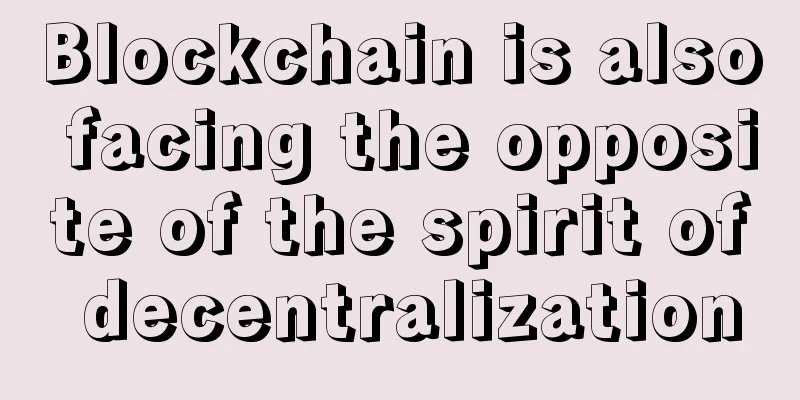Blockchain is also facing the opposite of the spirit of decentralization

|
With the continuous development of blockchain technology, many applications born on the blockchain that may subvert traditional industries have begun to emerge. This has also attracted huge funds to this market. Whether it is for institutions or individuals, if they want to enter the crypto market, they cannot avoid one thing, that is, centralized stablecoins. Centralized stablecoins provide a bridge between the real economy and the blockchain world, and are the value mapping of traditional finance in the crypto world, providing a stable value carrier. The emergence of centralized stablecoins has promoted the development of the blockchain world, but as the scale of centralized stablecoins continues to expand, blockchain is also facing a trend that runs counter to the spirit of "decentralization". This article is only a personal analysis and does not constitute any investment advice. If there is any incorrect content, please point it out. Author: Spinach Spinach, undocumented scholar Samo Table of contents1. Stablecoins: Value mapping between the off-chain world and the on-chain world 1. What is a stablecoin? 2. What is the significance of stablecoins? 2. Are mainstream stablecoins a continuation of the US dollar hegemony? 1. What is dollar hegemony? 2. How did the dollar hegemony come about? 3. How do mainstream stablecoins continue the dollar’s hegemony? 4. Why does the United States accept the challenge of issuing rights in the crypto world while other countries do not? 3. Where should the decentralized stablecoin ecosystem go? 1. The Dilemma of “Decentralization” 2. A grey future
1. Stablecoins: Value mapping between the off-chain world and the on-chain world1. What is a stablecoin?Stablecoin is a kind of on-chain crypto asset anchored to legal currency. Because of its low volatility, its main function is to serve as a medium of exchange between crypto assets with different volatility and a stable store of value. Stablecoins are mainly divided into centralized stablecoins and decentralized stablecoins: Centralized stablecoins: Crypto assets issued on the chain by centralized issuers with collateralized collateral from off-chain assets. They often promise that the "digital dollars" (such as USDT, USDC) they issue can be exchanged for real dollars at any time, which is the value mapping of the real economy into the blockchain world. Centralized issuers usually hire independent accounting firms or auditing agencies to regularly verify the reserve assets in the escrow account to ensure that the total value of their reserve assets is higher than the "digital dollars" they issue (that is, the company's debt). The largest mainstream centralized stablecoin is USDT issued by Tether, but the company has long been mired in controversy over its opaque assets and has failed to provide formal audit reports for several years. It did not begin to make its audit reports public until the first half of 2021. In addition, USDC, issued by a joint venture between Circle and the exchange Coinbase, and BUSD, approved by the New York State Department of Financial Services (NYDFS) and issued by Binance and Paxos, have developed rapidly this year due to their greater compliance. Together with USDT, they have occupied more than half of the crypto market. As of August 26, 2022, the combined market share of USDT (30.8%), USDC (29.5%), and BUSD (18.2%) has exceeded 75% of the entire stablecoin market. Data source: https://dune.com/hagaetc/stablecoins Decentralized stablecoins: Crypto assets generated by algorithms that are over-collateralized or uncollateralized by on-chain crypto assets. Decentralized stablecoins are not issued by centralized issuers, but are generated by self-executing smart contracts running on the chain, and are often governed by decentralized autonomous organizations (DAOs). Unlike centralized stablecoins, the issuance of centralized stablecoins means that real money has flowed into the crypto market, expanding the scale of funds, while the issuance of decentralized stablecoins does not currently lead to an expansion of the market, which is related to the way they are generated. Overcollateralized stablecoins, represented by MakerDAO's DAI, are stablecoins generated by overcollateralizing recognized on-chain volatile assets to lock liquidity. For example, 10,000$ of BTC is collateralized to generate 5,000$ of DAI. In essence, the liquidity in the market will not increase, and uncollateralized stablecoins generated by algorithms are a more unstable way. Terra's LUNA and UST's algorithmic stablecoins illustrate this point well. The model of LUNA and UST's mutual anchoring to create value out of thin air has huge flaws and collapsed immediately with liquidity problems. At present, the market share of decentralized stablecoins is still relatively small, among which MakerDAO's DAI is the leader in this field. As of August 26, 2022, DAI's market value is second only to USDT, USDC and BUSD, with a total supply of 6,972,989,621, which is about 10% of the total supply of USDT. Data source: https://coinmarketcap.com/zh/view/stablecoin/ 2. What is the significance of stablecoins?The significance of stablecoins is to maintain price stability by anchoring fiat currencies and crypto assets, so that a stable trading medium exists between different volatile crypto assets, which greatly improves transaction efficiency and asset security. Although centralized stablecoins and decentralized stablecoins are both stablecoins, they play different roles. The significance of the existence of centralized stablecoins Before the emergence of stablecoins, if people wanted to buy BTC, they had to find sellers who held BTC. It was very troublesome to directly purchase crypto assets on the chain with fiat currency. The purchase process might be: the seller provides a payment channel such as a bank account, etc. - the buyer transfers the money to the seller's payment channel - the buyer provides a wallet address - the seller transfers BTC to the buyer's address. This process may take more than ten minutes or even dozens of minutes. If it is an over-the-counter transaction, there may be a risk of the seller running away. Due to the high volatility of crypto assets, there may be drastic fluctuations within a few minutes. If there are drastic fluctuations during the transaction between the buyer and the seller, the final transaction price may be affected. And for institutions, because the amount of funds of institutions is generally very large, it is extremely difficult to find a counterparty of the corresponding size and there is a high probability of encountering moral risks of sellers. After the emergence of centralized stablecoins, both institutions and individuals can exchange fiat currencies for stablecoins pegged to fiat currencies and store them in on-chain wallets. Therefore, the significance of centralized stablecoins lies in their low volatility. Not only can they serve as a store of value and a "safe haven" when the market fluctuates violently, but they can also be used as a transaction medium to quickly match buyers and sellers on the trading platform, greatly improving transaction efficiency and providing the entire crypto market with a safe value carrier to carry larger amounts of funds. The significance of decentralized stablecoins After the birth of centralized stablecoins, people tried to create a decentralized stablecoin, that is, a digital currency that is not issued by any centralized entity, is completely decentralized, has stable prices, high reliability, is universally used, is not manipulated, and is not affected by trust crises. MakerDAO's DAI was born as the first decentralized stablecoin. DAI is minted through an over-collateralized model and has a complex system to ensure that the price of DAI remains stable and pegged to the US dollar. In addition to decentralized stablecoins with over-collateralized models, algorithmic stablecoins and partial algorithmic stablecoins were born. Although decentralized stablecoins are becoming more and more diverse, at present, decentralized stablecoins cannot replace the role of centralized stablecoins and are even extremely dependent on centralized stablecoins. Decentralized stablecoins have the same role as centralized stablecoins in terms of being a medium of exchange, provided that the price stabilization mechanism ensures that they can be pegged to fiat currency. However, they cannot replace centralized stablecoins in terms of their most important and core function as a store of value. Centralized stablecoins can act as a "safe haven" when the market fluctuates violently because the centralized issuing institutions behind them use fiat currency as collateral to protect their value. No matter how the market fluctuates, the price of centralized stablecoins can still maintain low volatility and can be redeemed for fiat currency, but it is difficult for decentralized stablecoins to remain unaffected when the market fluctuates violently. There are currently three ways to mint decentralized stablecoins, namely algorithmic, overcollateralized, and partially algorithmic collateralized. Purely algorithmic stablecoins are not stable and have extremely high risks, while overcollateralized or partially algorithmic collateralized methods require volatile assets or centralized stablecoins as collateral. If volatile assets are used as collateral, then when the market fluctuates violently, there will be a great risk of liquidation and it cannot be safely used as a store of value; if centralized stablecoins are used as collateral, then this decentralized stablecoin is more like a centralized stablecoin in a different shell. Although the risk of liquidation is very low, it will face the risk of protocol control at any time. Once the centralized stablecoin issuer imposes sanctions on the decentralized stablecoin protocol, then the centralized stablecoin will face the risk of zeroing out. Where does "decentralization, non-manipulation, and non-trust crisis" come from? It is almost impossible for the current decentralized stablecoins to solve the situation of being dependent on centralized stablecoins. Most of the underlying assets of mainstream decentralized stablecoins such as DAI, FRAX, and MIM are still centralized stablecoins (or liquidity tokens derived from centralized stablecoins). If the collateral is replaced with volatile assets, then the violent fluctuations will cause the decentralized stablecoin to decouple and make the stablecoin no longer stable. Therefore, the current decentralized stablecoin is more like a leverage tool. People obtain decentralized stablecoins by mortgaging assets to improve asset leverage and capital utilization efficiency, and use the decentralized stablecoins generated by mortgage to purchase volatile assets or generate interest again. This use has become the meaning of the existence of decentralized stablecoins at present, and there is still a long way to go before people can truly understand decentralized stablecoins. If the bridge connecting the decentralized world and the real world before the emergence of centralized stablecoins was a single-plank bridge that was difficult to walk on and could not carry a large amount of funds, then centralized stablecoins are the bridge connecting the two worlds, with smooth roads and the ability to carry huge amounts of funds, while decentralized stablecoins are branch bridges built on the bridge, providing different roads but always unable to escape the influence of the bridge. 2. Is stablecoin a continuation of the US dollar hegemony?1. What is dollar hegemony?The current state of hegemony We have heard about "dollar hegemony" in many places. We know that Americans can print green paper to exchange for goods and services from other countries. Every time they print money, they can pass on inflation to the world and reap the world. Especially recently, the euro has fallen from 10 yuan to 1€, which is about 1$. The yen, which has always been known as a safe-haven currency, has also fallen to a new low in decades. However, the reality always seems to be separated by a layer of gauze, making it difficult for people to see through the essence of the dollar hegemony. To understand this, we need to understand a word - dollar tide At the beginning of the epidemic, the Federal Reserve took the lead in printing money, and central banks of various countries followed suit. Most of the stock markets and real estate asset prices in the world began to soar, and people even forgot the historic moment of the three circuit breakers in the U.S. stock market a few months ago, and forgot that this was a new high against the backdrop of a severe blow to the real economy. This is the first wave of the dollar tide: in the rising tide stage, core areas such as Wall Street received a large amount of low-interest dollar loans and obtained a huge amount of low-cost funds. What was the first thing they did? Of course, they bought assets everywhere, such as gold, stocks, and real estate, until the prices of all traditional industry assets were so high that people could not afford them. A lot of funds with nowhere to go flowed into the crypto market. This part of the funds flowing into the crypto market allowed us to witness BTC breaking through the historical high of 60,000 US dollars. If we observe the market capitalization trend of the entire crypto market, we can find that since the Federal Reserve started printing money in 2020, major centralized stablecoin issuers have begun to issue more stablecoins, and the market capitalization of the entire crypto market has also begun to rise until it reached its historical high. This is also a key reason for this bull market. Data source: https://www.statista.com/statistics/1255835/stablecoin-market-capitalization/ Data source: https://coinmarketcap.com/charts/ This time the tide is not accidental. Such moments always occur periodically in history, and at that time, the assets in emerging markets are often driven up by low-interest dollar capital. For example, in the 1990s, when small Southeast Asian countries such as Thailand took over the transfer of Japanese industrial chains, the investment bubble was blown up. At that time, foreign investment painted a wonderful growth story, and the emerging markets of small Southeast Asian countries fell into a frenzy. In the double carnival of the stock market and the real estate market, the players who entered the market first have quietly cashed out at high positions, divided the sweetest cream on the cake, and are ready to wave their sleeves and turn around and leave. There is a rise and there is a fall. The interest rate cut cannot continue forever, and then there will be the second wave: the ebb tide stage. Contrary to the interest rate cut, shrinking the water volume is naturally a rate hike. This word has been fully demonstrated in the shouting of the current Federal Reserve Chairman Powell in the past few months. Every time he shouts, some of the money in everyone's pockets will fly away. The following figure will briefly describe how the US dollar hegemony uses the US dollar tide to harvest in the crypto market. Looking back at historical moments, a similar example is the capital flight during the Asian financial crisis in 1997. Interest rate hikes mean an increase in the cost of borrowing. Without a unified order from anyone, Wall Street capital and international hot money that had previously borrowed a huge amount of money knew that the party was coming to an end, and began to accelerate the sale of assets in the peripheral markets in exchange for US dollars, either repaying US dollar loans or exchanging them for low-risk assets such as US Treasury bonds. In this process, even the capital of emerging countries will begin to sell off and short their own assets together, and they will rather die than let their friends die. To a certain extent, it can also cause the exchange rate of small countries' currencies to collapse, so Soros had the opportunity to snipe the Thai baht and the Hong Kong dollar. In the end, the wealth accumulated by emerging countries over decades of hard work was plundered in a short period of time. Is this the end of the story? The tide rises and falls, and there is another round after one round. When the emerging markets are in a mess, with a large number of bankruptcies and assets hitting the bottom, the US dollar begins to cut interest rates again. Wall Street and international hot money take cheap dollars and return to various countries to start buying high-quality assets at low prices. Such a cycle of dollar rises and falls is called the dollar tide. In the most recent 10 cycles of interest rate cuts and hikes in the US dollar in history, 7 of them ended with a recession in the real economy, and the United States recovered first after taking advantage of the situation. The 3 cycles that did not cause a recession were accompanied by the harvesting of weak emerging markets. Although the dollar hegemony uses the dollar tide to make it look like a bandit harvesting the world, there is also a positive meaning behind it. Everything has two sides. This has to start with the origin of the dollar hegemony. 2. How did the dollar hegemony come about?The beginning of hegemony Looking back at the history of the last century, there was the economic crisis that swept the world in 1929. This most famous economic crisis in human history started from the United States and spread to Europe, causing countless people to lose their livelihoods. It also indirectly prompted countries whose economies were about to collapse to start wars to divert conflicts, leading to the outbreak of World War II. The two world wars shattered the twilight hegemony of old Europe. After World War II, the entire Europe, whether victorious or defeated, became losers with heavy debts. On the other hand, the United States got a respite thanks to Roosevelt's New Deal, but Roosevelt's packaged policies had many contradictions, and whether they really helped the United States get out of the economic crisis has always been controversial. There is no doubt that World War II hardly endangered the US mainland, and the huge military orders did help the United States get out of the quagmire thoroughly, and the subsequent conversion of military supplies to civilian use allowed its manufacturing and technological innovation capabilities to continue to maintain their advantages in the next few decades. Bretton Woods Era When establishing the new order after World War II, the United States, as the only two countries still standing on the crooked poker table and the largest creditor of European countries, which had 70% of the world's gold reserves during the gold standard era, naturally became the voice in establishing the new order after the war in the West. In 1944, the United States established the Bretton Woods system, pegging the dollar to gold and the currencies of various countries to the dollar, implementing the "quasi-gold standard". The dollar officially became the core currency in the global economy, also known as the "US dollar". Objectively speaking, the establishment of the Bretton Woods system played a vital role in the stable recovery of the world economy. If the United States had pursued its usual isolationism at the time and ignored things outside the American continent, the weak European countries would have been likely to fall into vicious competition. Because of the weak national strength, printing money has become one of the few options for governments, and printing money is equivalent to exchanging white paper for goods and services from other countries to take advantage. At the same time, the depreciation of the exchange rate can also make the country's export products more competitive. From the beginning, if you try to print more secretly, it will soon develop to the point where printing slowly will not work. The currencies of all countries will fall into a vicious competitive depreciation situation, the global exchange rate will fluctuate greatly, and trade will be in chaos. At this stage, the United States played the role of referee in the global political and economic environment, providing important public products for the post-war global economic recovery, which has positive significance. In the past era of the gold standard, the currency could not be increased at will, and the anchor behind it was gold. However, the Bretton Woods system had its inherent contradictions (i.e., the Triffin Dilemma). If countries wanted to use and reserve dollars, they needed to have dollars first, but Western countries no longer had gold reserves to exchange for enough dollars. At the same time, the United States, as the most powerful exporter in the manufacturing industry at the time, had excess capacity and was eagerly waiting for foreign orders to buy the goods it produced. If the U.S. dollars were taken out and lent to other countries, the U.S. dollars in circulation would decrease sharply, leading to deflation, and the appreciation of the dollar would also seriously hurt U.S. exports. Therefore, the only solution was to print more US dollars and directly lend them to foreign countries through aid loans (i.e., the Marshall Plan) without affecting the circulation of US dollars in the country. The US dollar became the core currency in global trade, stabilizing the exchange rate for countries after the war, providing a stable prerequisite for the recovery of the global economy, and also enjoying the benefits of the issuance tax. When everyone was poor and struggling to rebuild, everyone lived in peace. After all, a stable economic environment was more important than being taken advantage of by the United States. This status quo lasted for nearly 30 years, and the US dollar penetrated deeper into all aspects of the global economy. However, in the process, the United States gradually played the game of ten bottles and nine caps, and in the subsequent local wars, it squandered too much wealth, and the number of caps began to decrease. Post-Bretton Woods Era The first pragmatist who exposed the emperor's new clothes was Charles de Gaulle of France. He took a warship carrying a large number of US dollars and exchanged them for gold and shipped them back to France. He then borrowed a large number of US dollars from the market with gold as collateral and exchanged them for gold again. After several shipments, by 1971, France had bought back more than 3,000 tons of gold. At the same time, the Americans had played the game of printing money to the point of having ten bottles with one cap. The US gold reserves were only $11 billion, while the US's external current liabilities had reached $67.8 billion. In August 1971, Nixon announced the closure of the window for converting U.S. dollars into gold, which was essentially a unilateral breach of contract with the whole world. However, as the core currency of world trade for 30 years, the status of the U.S. dollar was not easily replaced, because at that time no country's currency had the ability to challenge the status of the U.S. dollar. Later, the United States found that as long as it controlled energy and food, the status of the U.S. dollar would continue to be unbreakable, so the U.S. dollar-oil system was established later, and most of the world's food giants and seed giants were also under the control of U.S. dollar capital. Where is the anchor? So the question is, now that the gold standard has been abandoned, what is the basis for the legal currencies of various countries to be issued? The answer is "debt". For central banks of various countries, it is the "sovereign debt" issued by the central bank. In the balance sheet of the central bank, every 1 yuan of legal tender base currency issued corresponds to 1 yuan of national debt, and the total amount is balanced. In theory, this is a very sophisticated new design of the human monetary system, because issuing debt requires interest and is not free, so governments cannot print money indiscriminately like in the old legal tender era. This sounds reasonable. Of course, things will gradually change. If you are the only referee in this game, and there is no stronger power to make you pay any extra price for borrowing new and repaying old debts, then you will feel happy when you borrow money, and you will feel happy when you keep borrowing money. Data sources: Center for Financial Stability (CFS), Johns Hopkins University, Federal Reserve, Wind, Orient Securities Wealth Research Center The red figure in the above figure is the amount of the Federal Reserve's balance sheet (liabilities and assets are equal). There is an illusion here, that is, the growth from 1971 to the beginning of 2000 is not obvious. In fact, it is suppressed by the massive money printing during the 2008 financial crisis. Excluding the data after 2008, you will still see an exponential growth curve. Nowadays, the MMT theory (Modern Monetary Theory) is even popular in American politics. This theory was originally a crooked leftist in economics in the early years, but it is particularly in line with the thoughts of the fiscal authorities. Although its theory cannot be said to be irrational, it can at least be said to be nonsense. It can basically be understood as: although the US dollar is the world currency, the printing of money is our internal affairs and no one has the right to interfere. It deeply interprets what it means to be "our currency, their problem". In 2020, in response to the impact of the COVID-19 pandemic, the total amount of money released into the market by the global central bank QE exceeded the total amount of money ever issued by mankind! So far, after the collapse of the Bretton Woods system, the human legal currency system has been completely ruined and is heading towards a course where no one knows the outcome. Let us review the mood of Satoshi Nakamoto when he witnessed the subprime mortgage crisis in 2008. How important is a currency that is not controlled by anyone and will never be issued? 3. How do mainstream stablecoins continue the dollar’s hegemony?At the beginning of Bitcoin's creation, Satoshi Nakamoto hoped to make Bitcoin a currency that can circulate in the market. Later, various cryptocurrencies and Bitcoin trading pairs were indeed formed in the blockchain world. Unfortunately, it is a bit inhumane to use a currency with extremely volatile prices to measure the prices of other things. Today, BTC is only struggling in the hearts of a few of the most devout hardcore players, and the result of market selection is that the scale of stablecoin trading pairs has become mainstream. If we regard the entire crypto world as a small emerging country, this country once tried to implement the "gold standard" monetary system with digital gold BTC, but after encountering various difficulties, it compromised with stablecoins. Stablecoins are actually the product of regulation, but later we found that stablecoins played a huge role in value anchoring and value circulation. Every country can issue stablecoins, but the most important thing about stablecoins is that they are anchored to the US dollar, because the US dollar has the widest application scenarios, is the most agile, and is the strongest. However, trading with stablecoins, especially centralized stablecoins, will lead to a certain loss of sovereignty. We can understand centralized stablecoins as "vouchers" for the US dollar. USDT, USDC and the like have given up independent fiscal policies and are unable to adjust their interest rates and supply in the crypto world, thus achieving free capital flow and exchange rate stability with the US dollar. Decentralized stablecoins (algorithmic stablecoins) try to achieve a balance between Mundell's impossible triangle, maintaining exchange rate stability while maintaining the free flow of capital as much as possible. On the basis of these two, they also greedily want to obtain independent monetary and fiscal policies. The one that has gone the furthest is LUNA-UST, which, at its peak, forcibly issued tens of billions of "dollars" at a "base interest rate" of 20% without the permission of the Federal Reserve. For a time, it was called "Crypto Moutai" by most people. Of course, we all know the story behind it. In fact, as a reflection of the real-world dollar, stablecoins are themselves the best bridge for the U.S. dollar hegemony to exert influence on the world of crypto assets. Just as the secret of the U.S. dollar tide plundering emerging economies is the "free flow of capital", and the U.S. dollar equivalent is chosen as the mainstream of market transactions, then the rise or fall of the U.S. dollar index, the influx or retreat of the U.S. dollar tide, will all pass through this bridge and affect the entire crypto world. Therefore, the U.S. dollar hegemony can not only directly shake the entire crypto world through stablecoins, but also almost a large number of centralized stablecoin issuers are regulated and controlled by the United States, and can arbitrarily freeze and control the stablecoins on the chain. 4. Why does the United States accept the challenge of issuing rights in the crypto world while other countries do not?The birth of blockchain has given everyone the right to issue their own encrypted assets. To a certain extent, it has grown wildly in the regulatory vacuum, creating a lot of chaos. Many countries have adopted corresponding regulatory bills to regulate this new market. Some countries have relatively loose policies, while others are relatively strict. Western countries led by the United States tend to be more open to this. It stands to reason that allowing corporate entities to issue tokens such as USDC, or privately issued "dollars" such as UST, which are not officially issued by the United States Central Bank digital currency, is a challenge to its issuance rights. Why would the United States tolerate such a challenge? First of all, the development of blockchain technology is increasingly showing its potential, and more and more people believe that this is the technological revolution of the next generation. The US dollar hegemony is not only about fleecing the world, but also actually gathers the most funds and top talents in the world, retains the best innovation environment, and has always made positive contributions in the research and marketization of new technologies. It is not in its interest to inexplicably reject a leading technology. It is its consistent style to make the United States the main force of new technologies and continue its technological influence. Secondly, taking the lead in accepting the crypto world and encouraging other countries to accept it may seem to put the currencies of various countries on the same starting line as the US dollar, but in fact the US dollar is a big step ahead. Even if any country issues legal digital currency on the blockchain with official endorsement, it cannot break through the proportion of its legal currency in the real economy. The market will always choose the US dollar, which has the highest adoption rate in the real economy, as the main anchor. The current situation is that stablecoins are basically pegged to the US dollar, which also allows the US dollar hegemony to better act on the crypto world through stablecoins, which is a hundred benefits and no harm to the US dollar. Again, if we assume that the United States boycotts the crypto world and does not allow the dollar to flow into the crypto world, other fiat currencies may not necessarily follow the dollar's decision. For example, the euro, which currently has the second largest market share, turns to strongly support blockchain technology. In a few years, when the technology explodes, the dollar's position may be overturned. Therefore, the strategy that best serves the interests of the United States is to embrace the crypto world and allow the United States' advantages to continue in this field, just as companies such as Google and Meta are acquiring any company that has the opportunity to subvert themselves, rather than rejecting and suppressing it, leaving mines for competitors to subvert themselves. For countries outside the United States, such as European countries and developed economies such as Japan and South Korea, accepting the crypto world can continue their relative advantage in the existing economic system; more peripheral economies face difficulties, because once accepted, it is equivalent to continuing to endure the advantage of the US dollar one step ahead and continuing the relatively backward position in the original pattern. At the same time, it will also face greater systemic financial risks due to the opening of capital flow exposure. For example, for countries with foreign exchange controls, their monetary policies have made trade-offs, giving up the free flow of capital to ensure exchange rate stability and independent fiscal policy, and the three cannot be taken into account at the same time. Accepting the crypto world is equivalent to asking them to have all three, which is contrary to their monetary policy. 3. Where should the decentralized stablecoin ecosystem go?1. The Dilemma of “Decentralization”Many believers in the "decentralized spirit" are trying to create a stablecoin that originates from the crypto world itself to get rid of the control of the US dollar hegemony over the crypto world. We can see many attempts, such as the algorithmic stablecoin, which uses the three-currency model of Share, Bound, and stablecoin, BasisCash, the simpler and cruder LUNA-UST dual-currency model, and Ampl, which attempts to abandon the US dollar and anchor the entire crypto asset itself. It was once called the Rebase stablecoin because its technical feature is to automatically return to normal by changing market supply and demand after the coin price is unanchored, but in the end these attempts seem to have failed. The most promising ones may be over-collateralized stablecoins that are realized through over-collateralization and liquidation, such as DAI and sUSD. Because they are based on smart contracts and have clear stability rules, they were once called algorithmic stablecoins, but after the UST crash completely ruined the reputation of algorithmic stablecoins, everyone distinguished them as "over-collateralized stablecoins." Over-collateralized stablecoins have maintained a relatively reliable performance so far because they always have sufficient collateral as value support. After Tornado Cash was sanctioned by OFAC, the first sanction against the protocol in history brought the entire crypto industry to a huge turning point, and the regulation of the crypto industry also entered an unknown area. This is an unprecedented sense of crisis for decentralized stablecoin protocols. Once a decentralized stablecoin protocol that relies on centralized stablecoin collateral is sanctioned, it is basically equivalent to declaring the death of the entire project. MakerDAO's founder Rune and core community members are aware of this risk and are considering starting to promote the decoupling of DAI from centralized stablecoins, and using ETH as collateral to prevent the risk of MakerDAO being sanctioned. Image source: Twitter If stablecoins are generated solely with ETH as collateral, this pure path will also have difficulties that are difficult to overcome. It will be trapped by the volatility of the underlying assets for a long time, which can easily lead to depegging and liquidation. The market size will also always be difficult to grow, and it will fall into a vicious cycle where it is not easy to use, so no one pledges it for minting, and no one mints it, resulting in a small supply. The smaller the supply, the more difficult it is to use. However, if MakerDAO continues to use centralized stablecoins as collateral for the sake of stability, it will always be controlled by the U.S. government behind the centralized stablecoins. If DAI grows to threaten the hegemony of the U.S. dollar one day, the Federal Reserve can easily freeze all of its centralized stablecoin assets on the grounds of "non-cooperation with supervision", and it will completely lose the qualifications to compete with the hegemony of the U.S. dollar - although it never had it from the beginning. And before Tornado Cash was sanctioned, the FRAX community launched a proposal: to increase the collateral ratio to 100%, which means that minting FRAX will no longer be a certain ratio centralized stablecoin and governance token, but a 100% centralized stablecoin collateral issuance. The intention of this move seems to be to increase FRAX's underlying credit to achieve the effect of scale expansion, allowing more and more users to use FRAX, but at the same time it also relies more on centralized stablecoins. Source of the proposal: https://gov.frax.finance/t/move-collateral-ratio-to-100-institute-credit-ratio/1371 (II) The Gray FutureFor decentralized stablecoins, there seem to be only two paths to go. One is to succumb to centralized stablecoins and rely on centralized stablecoins to be a tool to "improve capital efficiency" and constantly find ways to expand the scale for more people to use. Projects that choose this path may not care whether they go to decentralized or not, but whether more people can use it to increase the benefits of the protocol. The other path is to explore the real "decentralization", which is the most difficult path and is the goal that those true believers of blockchain spirit yearn for. For MakerDAO, which is moving towards "decentralization", there is a gray future ahead. MakerDAO not only has to face protocol sanctions that may occur at any time, but also faces the risk of project collapse due to failure in transformation. The road is long and long. Although the crypto world seems to be running contrary to the "decentralized spirit", it is difficult for us to see the development of technology at this time. Just as people in the era of carriages can hardly imagine the future of cars replacing carriages. For example, users of old Internet in the PC era always despise the subversion brought by mobile Internet, and the big giants of Web2 manufacturers will also have various discomforts when they first enter Web3. The charm of this industry is the amazing iteration speed, from the earliest BTC to the "blockchain world", to the "crypto asset world", to the world of crypto assets we call ourselves "Web3". This is not just an iteration of propaganda terms, but also the rapid development of technology. With huge capital investment, more and more Buidlers around the world are migrating in. The future situation will inevitably exceed the imagination of all our authorities. Perhaps in the future, the current dilemma will be solved in an unexpected way. |
>>: V God Girl: A Brief Thought Behind the Spread of Meme Images
Recommend
What do more than 20 big Vs like Ba Shusong and Huo Ju think about Bitcoin? Come and listen!
In late May and early June, Bitcoin experienced t...
Prefer to be alone and afraid of contact with people
In real life, when we communicate with others, we...
The face of a man who is destined to have a romantic relationship
The face of a man who is destined to have a roman...
During the flood season, has the miners’ spring returned?
Author | Hash Pie - Unbroken In April, a wall of ...
The face that likes novelty and is most good at playing with emotions
Some people are not pure in their feelings, they ...
What kind of facial features tell us that our fortune is declining?
People will not always have good luck, nor will t...
What does a mole on the palm mean? Does it affect your fortune?
People will experience many things in their lives...
Palm lines that indicate emotional infidelity
Palm lines that indicate emotional infidelity In ...
Is it true that women with flat noses spend money recklessly and have bad luck?
What does a woman with a flat nose look like? In ...
Bitcoin miners: Bitcoin plummets, should we leave or stay?
In the first half of this year, although some min...
Moles on the body related to career
Moles on the body related to career No matter whe...
Physiognomy: Are you a person with good taste?
Physiognomy: Are you a person with good taste? In...
Which men are destined to remarry?
Marriage is very important to everyone. It can be...
What does it cost for Proof of Stake (PoS) to work securely and successfully?
Proof of Stake (PoS) has always been the most con...
See your character and destiny through palmistry
See your character and destiny through palmistry ...









